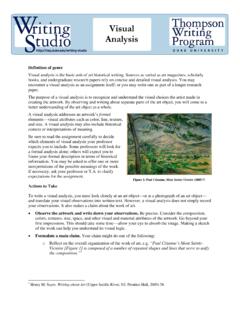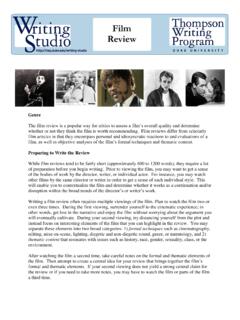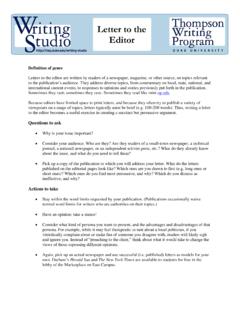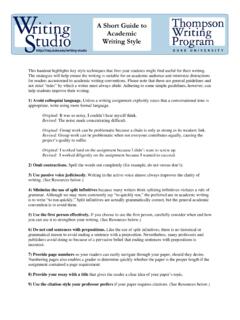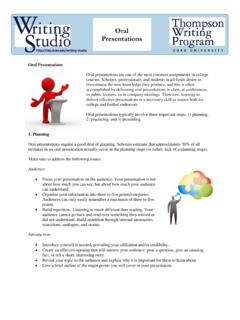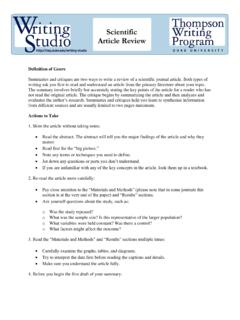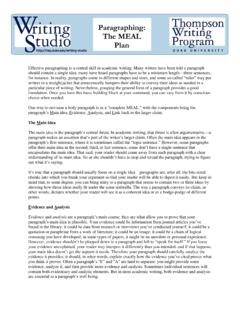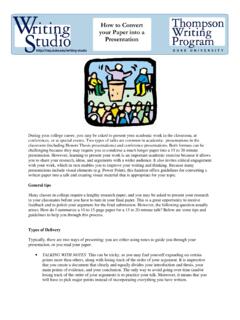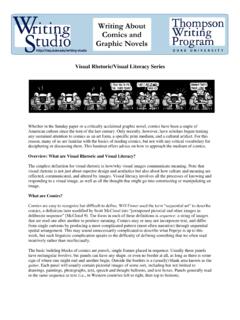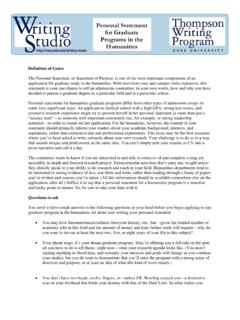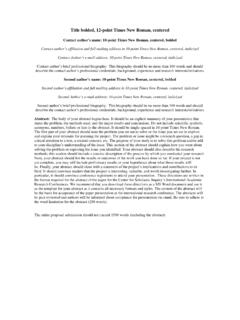Transcription of Duke Writing Studio 1 Policy Memo - Duke University
1 Duke Writing Studio 1 Policy memo Definition of Genre Policy memos are not like other academic papers. Their main purpose is to provide analysis and/or recommendations regarding a certain issue, and they are written for a specific, often limited, audience. Because of the need for quick, accurate information in the Policy world, Policy memos are written so that readers can efficiently access fact-based information in order to make an informed decision. Memos should, therefore, try to inform the audience in a concise , organized, and professional manner, while still including the most relevant content.
2 Writing criteria for Policy memos An effective memo will do its job if the reader comprehends the main points after one quick read or even after reading just the first sentence of each section. To ensure that the memo gets the intended results, pay close attention to the following: (1) content, (2) structure, (3) organization, (4) word choice, and (5) clarity. Content Content, of course, is the most important determinant of a good Policy memo . Weak or illogical ideas, no matter how well-presented, do no one any good. Therefore, a memo should provide both accurate and relevant information, while also acknowledging the limitations of certain recommendations or analysis.
3 Any recommendations should include honest and realistic alternatives. Here are some things to keep in mind: Present the most relevant information and state your main ideas and any recommendations clearly. Make sure to present opinions as opinions and NOT as facts. Opinions presented should also be substantiated. Use logic and facts to support each of your main points and/or to refute opposing points. When citing facts in-text, be accurate. Avoid logical fallacies such as appeals to authority, slippery slope arguments, hasty generalizations, and faulty causation.
4 Structure 1. Header Structure, simply put, means how a memo looks. Most memos take the general form of an email, and the first page has To:, From:, Date; and a title that starts with RE:. Consider the following example (with bolding used to identify the parts): To: Timothy Geithner, Secretary of Treasury (Writer s Audience) From: Michelle (Min Eun) Jeon, Policy Advisor (Writer s name and title) Date: 2/20/2012 (Date) RE: Overcoming the Obstacle: House Speaker John Boehner (Title/Main Idea) The header as formatted above comes at the beginning of a memo .
5 With the header, the reader will know to whom the writer is Writing , what authority the writer has to address the audience, and the most critical message of the memo . Duke Writing Studio 2 2. Executive Summary Below the header, a memo generally includes an executive summary, a single paragraph that summarizes the entire memo . After reading the memo just once, the reader can understand what the rest of the memo will explain. The executive summary can stand alone and allow the reader to look at the first paragraph and identify the main points of the rest of the memo .
6 Sample of an executive summary: Secretary Geithner s China currency bill depends on House Speaker John Boehner s support since the Speaker chooses which bill to debate in the House of Representatives. Mr. Boehner will only debate the bill after pressure from his financial supporters, security and investment corporations and their lobbyists; and his electoral constituents, Ohio State citizens and the Republican Party. A few things become obvious after reading this example. First of all, the audience, Secretary Geithner, will understand that he will get a certain bill passed only through pressuring House Speaker John Boehner.
7 Also, Secretary Geithner will be able to predict that the rest of the memo will elaborate on Mr. Boehner s financial supporters, security and investment corporations and their lobbyists; and his electoral constituents, the Ohio State citizens and the Republican party, the people who will have the most influence on Mr. Boehner. We can assume that the writer will provide statistics on why such groups hold the most power over Mr. Boehner s decision making process as well as a logical recommendation on how to get these groups to pressure Mr. Boehner. If the reader finds the main point to be very direct and clear in an executive summary, then the writer will have done his or her job well.
8 3. Subheading The rest of the paper will have several sections elaborating on the points indicated in the executive summary. Those sections will start with a subheading, usually in bold-font to make the title eye-catching for the reader. A subheading should generally be a summary of the section, so the reader will not necessarily have to read the rest of the section to understand the most important information the section contains. Example: Speaker Boehner: Greatest challenge for the currency bill Example: Mr. Boehner s pro-business interests Organization memo writers should employ a common skill in journalism, called the inverted pyramid style of Writing .
9 This means memos should place the most important information at the top and have the less significant details follow in order or importance. In an academic paper, you would mix up the order, usually having the most important point come last. But in a memo , the most important fact should always come first. To visualize, this is what it would generally look like: Academic Paper Memorandum 2 1 (most important) 3 (least important) 2 1 (most important) 3 (least important) Such prioritization should always occur in every section of the memo , from the general large structure to small sub-sections.
10 Word Choice Word choice plays a critical role in making a memo clear and concise . Consider eliminating vague theoretical words and replacing them with more concrete, specific terms. Here are a few examples: Duke Writing Studio 3 Vague More Concrete facilitate help/assist indicate say/show concept idea Clarity Policy memos must be clear and direct so that readers can understand the main points quickly. If the memo writer has focused on building strong content that is well organized, and if the Writing exhibits well-chosen language, then the result is a clear argument.
